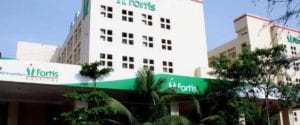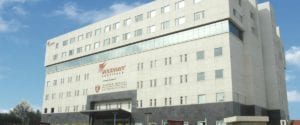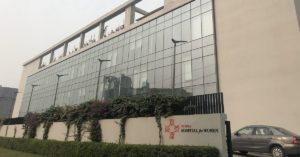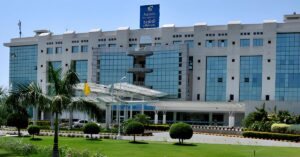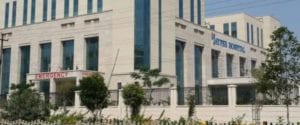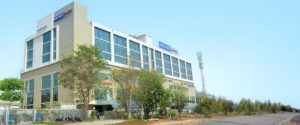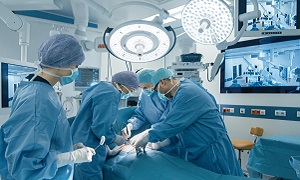Best Doctors in India for Myelopathy Treatment
Best Hospitals in India for Myelopathy Treatment
- City: Mumbai, India
Hospital Highlights:
- Fortis Hiranandani hospital was established in 2007.
- The hospital is an advanced tertiary care, multi-specialty hospital equipped with 149 beds.
- The hospital is equipped with a super ICU to provide emergency medical care to critically ill patients.
- The hospital is NABH accredited.
- The critical care facility in the hospital is augmented with the state-of-the-art facilities that facilitate speedier diagnosis and efficient monitoring.
- The hospital provides specialty medical services in cardiology, orthopedic science, pediatric science, neurology, diabetic care, urology, nephrology, ENT, obstetrics, gynecology, cosmetic surgery, bariatric surgery, neuro and spine care.
- City: Gurugram, India
Hospital Highlights:
- W Pratiksha Hospital, Gurugram, is one of the best hospitals in the NCR region. It is also a top hospital in India for IVF. Since its inception, the hospital has performed over 5500 successful IVFs. The hospital also specializes in gynecology.
- With over 20 years of experience in providing quality healthcare, the hospital is known as one of the most trusted and valued health providers in India.
- Equipped with world-class medical facilities and advanced technology, the hospital’s doctors and clinicians also have a track record of delivering excellent results. The hospital is also known for focusing on preventive well-being as much as on curative treatment.
- The hospital has earned the trust of its patients, by providing the best available treatments at affordable costs.
- City: Gurugram, India
Hospital Highlights:
- Paras hospital was established in 2006 and is the 250 bedded flagship hospital of Paras Healthcare.
- The is supported by a team of doctors of international and national repute.
- The hospital is NABH accredited and also the first hospital in the region to have a NABL accredited laboratory.
- The hospital provides specialty medical services in around 55 departments including Neurosciences, Joint Replacement, Mother & Child Care, Minimal Invasive Surgery, Gynecology and Obstetrics, Ophthalmology, Dermatology, Endocrinology, Rheumatology, Cosmetic and Plastic surgery.
- The hospital is equipped with state-of-the-art technologies.
- City: Kolkata, India
Hospital Highlights:
- Fortis Hospital, Anandapur, Kolkata is a world-class super-speciality equipped with the latest technologies in the medical world.
- The hospital is NABH accredited.
- This state-of-the-art facility specializes in cardiology and cardiac surgery, urology, nephrology, neurosciences, orthopaedics, digestive care, emergency care and critical care.
- The hospital, governed by integrated Building Management System (IBMS), has a pneumatic chute system, for quick vertical and horizontal transportation between floors, facilitating speedy transfer of patient specimens, documents, reports, and medicines to the concerned departments.
- The hospital also has a nephrology department with over 28 advanced dialysis units.
- City: Mumbai, India
Hospital Highlights:
- SL Raheja hospital is a 140-bed multi-specialty tertiary care hospital that is being managed by Fortis Healthcare Ltd.
- The hospital is a benchmark in healthcare and medical facilities in the neighborhood of Mahim & the western suburbs.
- L.Raheja Hospital, Mahim has one of the most effective ICU and Casualty care services.
- The hospital provides specialty medical services in Cardiology, Oncology, Neurology, Orthopedics, Mother & Child Care, and in Diabetes.
- City: Mumbai, India
Hospital Highlights:
- Wockhardt Hospitals were established in the year 1973, originally called First Hospitals and Heart Institute.
- Wockhardt Hospitals are super specialty health care networks in India, nurtured by Wockhardt Ltd, India’s 5th largest Pharmaceutical and Healthcare company.
- Wockhardt Hospitals is associated with Partners Harvard Medical International, an international arm of Harvard Medical School, USA.
- Wockhardt Heart Hospital performed India’s first endoscopic heart surgery.
- The hospital has a state-of-the-art infrastructure equipped with the latest technologies and modern equipment.
- It has special Centers of Excellence dedicated to the major specialties to provide hassle-free and high-quality clinical care.
- City: Gurugram, India
Hospital Highlights:
- The CK Birla Hospital in Gurugram is a NABH-accredited multi-specialty hospital.
- The hospital strives to increase the quality of healthcare by focusing on UK NHS nurse and midwife training requirements. Policies and practices derived from the National Institute for Health and Treatment Excellence (NICE) recommendations in the United Kingdom ensuring that a strong focus on safety, high-quality clinical care, and sanitation is maintained.
- The hospital’s cutting-edge technology and facilities allow for real-time communication and seamless collaboration among caregivers, ensuring accuracy and the best possible results. Those with foreign experience and accreditations make up part of the hospital’s team of clinicians.
- City: Ahmedabad
Hospital Highlights:
- As a member of the Apollo Hospitals Group, Apollo Hospitals International Limited, Ahmedabad is one of the most popular and sought-after medical facilities in Gujarat.
- Through its 6 Centres of Excellence and various affiliated branches, which cover all specialties and subspecialties, the hospital provides the most advanced clinical services.
- Since its inception in 2003, the hospital has been providing each patient with the most up-to-date medical equipment and state-of-the-art technology.
- With more than 150 successful organ transplants, including liver and renal transplants, the facility has been able to build a strong and extensive organ transplant program.
- In addition to performing 600 surgeries and caring for over 1800 patients on an IP basis, the hospital sees more than 18,000 patients on average in the outpatient department.
- With one of the biggest cardiology teams in the area, the hospital provides state-of-the-art regional care treatment in Cardiac Sciences.
- Additionally, the hospital offers a broad range of Neuro Interventional techniques to help stroke patients recover more quickly.
- City: Noida, India
Hospital Highlights:
- Jaypee Hospital is the flagship hospital of the Jaypee Group.
- This hospital has commissioned 525 beds in the first phase and has been planned and designed as a 1200 bedded multi-specialty facility.
- It holds the accreditation of the NABH and NABL.
- The hospital has state-of-the-art infrastructure equipped with the latest technologies and modern equipment like 64 Slice PET CT, Dual Head 6 Slice SPECT CT, Gamma Camera, and Da Vinci Robotic Surgery for comprehensive robotic surgical solutions.
- It has special Centers dedicated to the major specialties to provide hassle-free and high-quality clinical care.
- City: Mumbai, India
Hospital Highlights:
- Reliance Hospital is one of the best super-specialty care hospitals in Navi Mumbai.
- The main purpose of this hospital is to become a trustworthy place for the best health and hope for society. The hospital is well connected to the suburbs of Mumbai and Navi Mumbai.
- The hospital has various specialty departments, viz., Accident & Emergency, Anesthesiology, Dental Services, Dermatology, Diabetology, Dietetics Nutrition, Endocrinology, ENT, Gastroenterology, General Surgery, Gynaecology And Obstetrics, Hepato Pancreato Biliary Surgery, Infectious Disease, Internal Medicine, Interventional Radiology, Laboratory Medicine, Minimal Access Laparoscopic Surgery, Nephrology, Neurosciences, Opthalmology, Orthopaedics, Paediatrics, Pain Management Palliative Care, Physical Medicine Rehabilitation, Plastic And Reconstructive Surgery, Psychiatry, Pulmonary Medicine, Radiology, Rheumatology, Transplant, Urology Andrology, Vascular Surgery
Myelopathy
Myelopathy is an injury to the spinal cord caused by severe compression. This compression may result from trauma, congenital stenosis, disc herniation, or degenerative disease. Your spinal cord is a group of nerves housed inside your spine running almost its entire length. If any portion of the spinal cord gets compressed or constricted, the resulting symptoms are termed myelopathy.
Types
Depending on where the condition is on the spine, there are various types of this condition:
Cervical myelopathy- This type of myelopathy affects the neck and is also the most common form of this condition. It’s generally caused by degeneration in the cervical spine, and it might lead to weakness, numbness, and tingling in your hands, arms, and legs.
Thoracic myelopathy- This type of myelopathy affects your mid-spine. It’s generally caused by bulging or herniated discs, bone spurs, or in some cases, spinal trauma. The signs and symptoms generally come on slowly, unless the cause of the compression is trauma. Some of these symptoms include numbness and weakness in the legs, loss of coordination, as well as difficulty in walking.
Lumbar myelopathy- This is the least common type of myelopathy, which affects the lower part of the spine, also known as the lumbar region.
Symptoms
When your spinal cord is compressed or injured, it might lead to loss of sensation, loss of function, as well as pain or discomfort in the area at or below your compression point. Some other symptoms of myelopathy include:
- Neck, arm, leg, or lower back pain
- A sensation of tingling, numbness, or weakness
- Increased reflexes in extremities or the development of abnormal reflexes
- Difficulty with fine motor skills, such as buttoning a shirt or writing
- Difficulty while walking
- Issues with balance and coordination
- Loss of urinary or bowel control
Generally, the exact symptoms depend on where in the spine the condition is present.
Causes
Myelopathy generally develops slowly due to the gradual degeneration of the spine, but it might also take an acute form or stem from a spine deformity that was already present at birth. The most common causes are generally degenerative spinal conditions, such as spinal stenosis, which is a narrowing of the bony passageways of the spine, through which the spinal cord, as well as the nerve roots, travel.
Central disc herniations may also result in compression on the spinal cord, which can lead to the development of myelopathy. Autoimmune disorders, like rheumatoid arthritis in the spine, may lead to degenerative changes as well, in the vertebrae which result in spinal cord compression and myelopathy.
Hernias, cysts, hematomas, as well as spinal tumors, including bone cancer, might also press on the spinal cord and lead to myelopathy.
Sometimes, acute myelopathy might also develop quickly due to spinal injury, spinal infection, inflammatory disease, neurological disorders, or even radiation therapy.
Diagnosis
Since the symptoms of myelopathy are not unique to the condition, your doctor is likely going to recommend the following tests for the diagnosis of the condition:
X-ray
An X-ray in order to rule out any other problems.
MRI
An MRI scan for a detailed look of the spine and spinal canal, which is able to show areas of stenosis.
Fluoroscopy
Fluoroscopy is used to reveal any abnormalities of the spinal cord. It is sometimes used instead of MRI for patients who are unable to sit inside the MRI machine.
Electromyogram
Electrical tests, such as an electromyogram might also be recommended. These tests measures how nerve stimulation in an arm, hand, leg or foot is connecting through the spinal cord to the brain.
In some cases, myelopathy is also added at the end of another underlying condition to indicate the involvement of your spinal cord. For example, your doctor might let you know that you are having cervical stenosis with myelopathy or thoracic disc disorder with myelopathy. Similarly, if your spinal cord is not involved, your diagnosis is going to say- ‘without myelopathy’.
If your myelopathy is caused as a complication of another disease, your doctor might refer to it in the terms of this disease. For example, diabetic myelopathy means that your spinal cord has been damaged due to your diabetes.
Treatment
Treatment is going to vary, depending on the type of myelopathy, how far the condition has progressed as well as the cause. For example, if a bacterial infection is the cause of your myelopathy, then treating the infection with antibiotics might treat the compression on the nerves. Some of the other possible treatments include:

